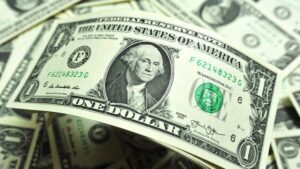
The ICE-calculated index showing the dollar’s dynamics against six currencies (euro, Swiss franc, yen, Canadian dollar, pound and Swedish krone) is losing 0.03% in trading, while the broader WSJ Dollar Index is stable.
The minutes of Wednesday’s Jan. 31-Feb. 1 U.S. Central Bank meeting showed that Fed policymakers plan to continue raising rates, believing that current levels are not enough to curb economic activity to beat inflation. At the same time, they believe that the cycle of rate hikes could be completed this year.
According to the minutes, meeting participants also noted that the restrictive policy will need to be maintained until the Central Bank has “confidence that inflation is on the path to a steady decline to the 2% level.”
Eurozone inflation stats released Thursday confirmed investors’ view that the European Central Bank will continue to tighten policy sharply.
According to final data from the European Union Statistical Office (Eurostat), consumer prices excluding food and energy (CPI Core Index, an indicator of core inflation) rose at a record annual rate of 5.3% in January. They had been previously reported to have risen 5.2% in January, and analysts did not expect the data to be revised.
The estimate for consumer price growth as a whole was revised to 8.6% annualized from the previously announced 8.5%, Eurostat said.
The euro/dollar pair was trading at $1.0603 as of 8:15 a.m., up from $1.0596 at market close on Thursday.
The pound is at $1.2023 from $1.2013 the day before.
The U.S. currency fell to 134.58 yen against 134.68 yen in trading during the previous session.
Kazuo Ueda, who was nominated as the head of the central bank by the Japanese government said during his speech in the parliament on Friday that he considered it reasonable to keep ultra soft monetary policy in Japan in order to achieve the central bank’s inflation target. At the same time, he made it clear that he sees various options for controlling the yield curve of government bonds in the future.
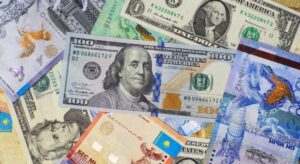
The US dollar is getting stronger against the euro, the yen and the pound sterling during trading on Tuesday.
Traders are awaiting the publication of the Federal Reserve System (Fed) meeting minutes from January 31 to February 1. The Federal Reserve Board decided to raise the rate by 25 basis points (bps) – to 4.5-4.75% a year.
Experts expect that the protocol may confirm the Fed’s intention to continue raising the rate longer than it was planned before, Trading Economics said.
The latest statistical data on the U.S. economy has “called into question” arguments that the Fed may soon halt its rate hike cycle or move to lower rates altogether, notes Chuck Camello, president and chief executive officer of Essex Financial Services.
“I think the market is finally coming to the realization that U.S. rates will be higher than expected, and longer than expected,” Bloomberg quoted the expert as saying.
Calculated by ICE index showing dollar dynamics against six currencies (euro, Swiss franc, yen, Canadian dollar, pound sterling and Swedish krona) added 0.13% during Tuesday’s trading, broader WSJ Dollar Index added 0.15%.
The euro/dollar pair is trading at $1.0672 as of 8:10 a.m., up from $1.0687 at Monday’s market close.
The pound fell to $1.2026 from $1.2041 the day before.
The value of the American currency against the yen rose to 134.39 yen against 134.26 yen in previous trading.
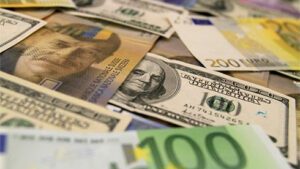
The U.S. dollar goes up against the euro, yen and pound sterling in trading on Friday on hawkish statements of Federal Reserve (Fed) executives, which strengthened traders’ opinion that the U.S. Central Bank is not going to stop the rate hike cycle yet.
Federal Reserve Bank (FRB) Cleveland President Loretta Mester said the day before that she had seen a “compelling case” for a 50 basis points (bps) rate hike at the January 31-February 1 Fed meeting.
The Federal Open Market Committee (FOMC) unanimously decided at that meeting to raise the rate by 25 bps, to 4.5-4.75% per year.
Mester still believes the Fed needs to raise the benchmark rate to more than 5% and keep it above that mark for a while to get inflation back under control.
St. Louis Fed Chairman James Ballard said Thursday that, like Mester, he supported a 50-bp rate hike at the last meeting. Neither Ballard nor Mester have a vote on the FOMC this year.
Ballard said he thinks the Fed should raise the rate to 5.25-5.5% and do it “as soon as possible. Thus, Ballard believes it is necessary to raise the rate by 75 bps from current levels, Market Watch notes.
“A further rate hike could help solidify the disinflationary trend in 2023 even as the economy continues to grow and the labor market is strong,” Ballard said.
The ICE-calculated index, which shows the dollar’s performance against six currencies (euro, Swiss franc, yen, Canadian dollar, pound sterling and Swedish krona), added 0.53% Friday, while the broader WSJ Dollar Index gained 0.38%.
The euro/dollar pair was trading at $1.0638 as of 7:45 a.m., compared with $1.0672 at market close Thursday.
The pound was down to $1.1948 from $1.1988 the day before.
The value of the American currency against the yen rose to 134.71 yen against 133.94 yen by the previous trading results.
The dollar/yuan pair is trading at 6.8755 yuan, compared to 6.8607 yuan on the previous day.
EURO, pound, U.S. dollar, yen
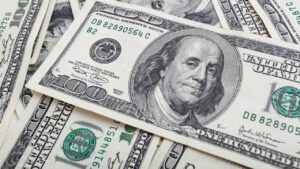
The U.S. dollar is strengthening against the euro, the yen and the pound sterling in trading on Friday.
The ICE-calculated index showing the dollar’s dynamics against six currencies (euro, Swiss franc, yen, Canadian dollar, pound sterling and Swedish krona) is adding 0.16%, while the broader WSJ Dollar Index is up 0.18%.
The euro/dollar pair is trading at $1.0722 as of 7:50 a.m., up from $1.0743 at the close of the previous session.
The pound is at $1.2097, compared to $1.2121 the day before.
The dollar went up to 131.74 yen against 131.54 yen at the close of trading on Thursday.
Signals that the Federal Reserve (Fed) may raise the benchmark interest rate higher than the market expects provided support for the American currency. Several Fed policymakers this week signaled they believe a further rate hike is necessary because the fight against high inflation has not yet been won and there is no significant slowdown in economic growth.
Next week, the January U.S. inflation data will be released. The consensus forecast from experts cited by Trading Economics suggests consumer prices are up 0.5% from December, when they fell 0.1%.
The Australian dollar fell in trading Friday to $0.6924 from $0.6937.
The Reserve Bank of Australia (RBA) raised its forecast for core inflation, which excludes food and energy costs, for the current fiscal year ending in June to 6.25% from 5.5%.
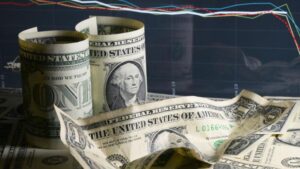
The U.S. dollar is getting cheaper against the euro, the yen and the pound sterling in trading on Tuesday after a strong strengthening following the previous session.
The ICE index showing the dollar’s movement against six currencies (euro, Swiss franc, yen, Canadian dollar, pound and Swedish krone) was losing 0.14% while the broader WSJ Dollar Index lost 0.27%.
The euro/dollar pair is trading at $1.0744 as of 8:20 a.m., up from $1.0726 at the close of the previous session.
The pound is at $1.2054, up from $1.2018 the day before.
On Monday the euro fell by 0.7% against the dollar, while the pound gained 0.3%. The U.S. currency was bolstered by strong U.S. labor market statistics for January, which showed that the Federal Reserve (Fed) still has enough room to maneuver in terms of further tightening monetary policy.
Rafael Bostic, president of the Federal Reserve Bank (Fed) of Atlanta, told Bloomberg on Monday that the Fed may have to raise rates higher than previously expected because economic activity in the U.S. is slowing weakly. “It’s going to mean we’re going to have to do a little bit more work,” Bostick said. – And I believe the Fed will have to raise the rate higher than I’m currently forecasting.”
Traders are waiting for more signals from Federal Reserve (Fed) Chairman Jerome Powell, who will speak at the Economic Club in Washington on Tuesday.
The dollar fell to 132.12 yen against 132.65 yen at the close of previous trading.
The yen weakened more than 1% against the dollar on Monday after the Nikkei newspaper reported that the Japanese government is offering the post of the central bank head to the current deputy Haruhiko Kuroda, who is retiring in April.
Masayoshi Amamie has been Kuroda’s deputy since 2018 and is considered one of the authors of the Bank of Japan’s ultra-soft policy. Experts believe that his appointment as head of the Central Bank increases the chances of preserving the current approach of the Japanese regulator to monetary policy, notes Bloomberg.
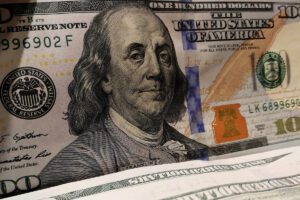
The ICE computed index showing the dollar’s trend against six currencies (euro, Swiss franc, yen, Canadian dollar, pound and Swedish krona) gained 0.15%, while the broader WSJ Dollar Index gained 0.09%.
The ICE dollar index jumped more than 1 percent Friday following the release of U.S. economic data showing that the U.S. labor market remains strong, leaving ample room for the Federal Reserve (Fed) to maneuver further tightening monetary policy.
According to the U.S. Labor Department, the number of jobs in the U.S. economy increased by 517,000 in January and unemployment fell to its lowest level since 1969, 3.4%.
This week, traders will be waiting for more signals from Federal Reserve (Fed) Chairman Jerome Powell, who will speak at the Economic Club in Washington on Tuesday.
During a press conference on the results of the January 31-February 1 meeting of the U.S. Central Bank, Powell acknowledged for the first time that “the disinflationary process has begun. He also suggested that the Fed rate, which was raised to 4.5-4.75% at the end of the meeting, would not exceed 5%, and reiterated that the Fed could achieve slowdown in inflation without causing significant harm to the economy.
The euro/dollar pair is trading at $1.0797 as of 7:55 a.m., up from $1.0799 at the close of the previous session.
The pound is at $1.2062, compared to $1.2056 at the close of the previous session.
The dollar rose to 131.71 yen against 131.18 yen the day before.